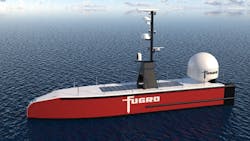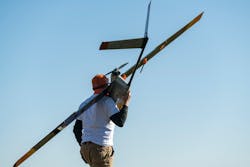Unmanned surface and underwater vessels receive new position system technology
In this week’s roundup from the Association for Unmanned Vehicle Systems International, which highlights some of the latest news and headlines in unmanned vehicles and robotics, Sonardyne provides an update for Fugro’s unmanned and remotely-piloted vehicles and a backup for standard GPS systems begins development.
Sonardyne Technology Selected to Support Fugro’s Fleet of Uncrewed Surface Vessels
By AUVSI News
Technology from Sonardyne has been chosen to support leading geo-data specialist Fugro’s global fleet of uncrewed surface vessels (USVs) and remotely-operated vehicles (ROVs).
Sonardyne’s Mini-Ranger 2 Ultra-Short BaseLine (USBL) position system will be integrated into Fugro’s new 12-meter long Blue Essence USV, the first of which will be delivered to Fugro’s base in Perth in February. Once integrated, the Mini-Ranger 2 will allow the Blue Essence to deploy, track, command and control ROVs and underwater autonomous vessels (UAVs) as part of inspection, survey and data harvesting projects - all of which will be controlled from Fugro’s onshore remote operations centers.
Ivar de Josselin de Jong, Global Solution Director for Remote Inspection at Fugro, said the integration of Sonardyne’s positioning system into Fugro’s uncrewed and remotely-operated vehicles is key in supporting the development of safer, more sustainable and more efficient approaches to the construction and maintenance of marine assets. “Our fleet will deliver an entirely remote-controlled inspection solution for the first time in history,” de Jong said. “And this will play a pivotal role in the rapidly growing offshore wind sector.”
Graeme Buchanan, Sales Manager with Sonardyne, added that Sonardyne is pleased to support the transition towards uncrewed operations in the marine sector. “Enabling entirely remote-controlled inspection with solutions such as our Mini Ranger 2 is delivering safer, more sustainable and efficient operations across the ocean space,” Buchanan said.
Mini-Ranger 2 is ideal for use from small vessels, where precise maneuvering is required. It can track up to 10 targets at very fast update rates and has a standard operating range of 995 meters – extendable to 4000 meters. The Marine Robotics software also contains additional capabilities, including secure data exchange and remote control of multiple UAVs in a swarm scenario.
Black Swift Technologies Contracts with NOAA to Develop a Backup Navigation System for when Standard GPS Fails
By Amy French
Jamming. Spoofing. Interference from the landscape or cityscape. Interference from other flight equipment.
Such snarls arise often enough with satellite signals to make it clear: Routine UAS flight beyond the line of sight (BLOS) will likely never happen with traditional GPS technology alone. To assure safe travel over long distances, unmanned aircraft systems need greater capability to ensure accurate positioning and routing.
With the need for a GPS-denied navigation solution in mind, NOAA’s Small Business Innovation Research Program has contracted with Boulder, Colo.-based Black Swift Technologies (BST). The 10-year-old company, known for designing UAS that can fly scientific payloads in demanding environments, has agreed to spend the next two years developing a diverse-source global positioning system (DS-GPS) as a backup for standard GPS.
“Basically, GPS is a single point of failure as far as a navigation solution,” said BST CEO Jack Elston. He ranked the need for GPS-denied navigation capability as perhaps the second greatest obstacle to BLOS, after the need for failsafe collision-avoidance technology.
“If GPS fails, you either have to have a very safe way of getting the aircraft down, which is not always easy beyond the line of sight if you happen to be flying over a city for package delivery or something like that. Or you have to have another method for getting your position.”
Instead of relying on satellite signals, the system that BST is developing uses augmented sensor suites. Sensors include cameras that enable machine vision and a software-defined radio that, together, help to ascertain the position of an aircraft. Also, by offering a basis for comparison, DS-GPS can help operators to gauge whether regular GPS is functioning correctly. GPS failure, Elston noted, can be hard to detect immediately – a point of uncertainty that underscores the risk of total reliance on GPS in BLOS flight.
In an early test that employed both standard GPS and machine vision to chart the same flight path, machine vision was able to match GPS keypoint by keypoint with a maximum error of 10 meters, Elston said. He expects that level of error should diminish considerably as development of DS-GPS continues.
Phase I of BST’s roughly $500,000 contract with NOAA began mid-2020 with a preliminary feasibility study. In January, BST got approval to enter Phase 2, during which the company aims for DS-GPS to reach commercial viability.
The biggest challenge, Elston said, will be finding the right data-gathering formulas for different flight conditions.
“We’re doing some fairly advanced machine vision algorithms,” he said. “So getting that integrated with the system will take some time. And it requires a lot of work to make sure that it works well above all sorts of different terrain and in different weather conditions, times of year, things like that.”
The end goal is a module that could be plugged into existing hardware on aircraft large enough and with enough battery power to be candidates for long flights. For testing, BST is using its own S2 UAS
BST intends to market DS-GPS to NOAA for such uses as surveying U.S. coastlines as part of NOAA’s National Geodetic Survey. Without BLOS capability, coastline survey teams can map only 2 miles at a time before they must relocate.
Other applications for drones that could become vastly more efficient with BLOS capability include aerial imaging, environmental observation, precision agriculture, and infrastructure monitoring and inspection.
Share your vision-related news by contacting Dennis Scimeca, Associate Editor, Vision Systems Design
SUBSCRIBE TO OUR NEWSLETTERS

